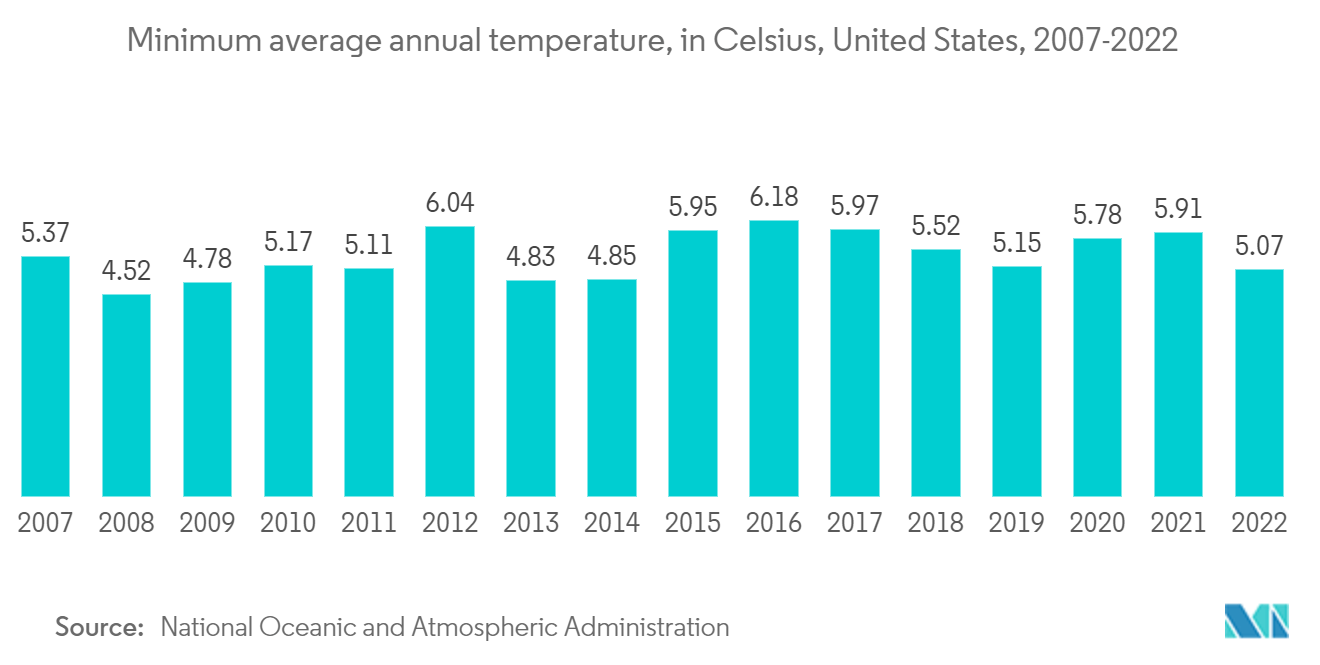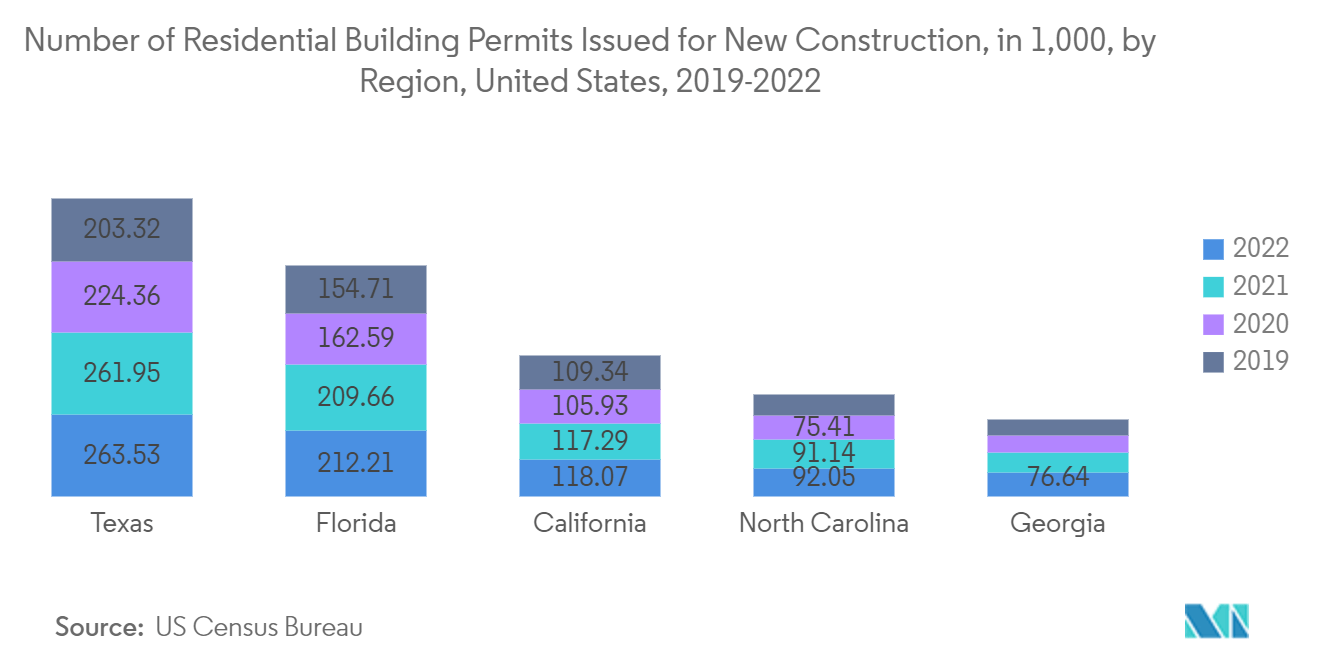Market Trends of US HVAC Field Device Industry
Damper Actuator HVAC Segment is Expected to Drive the Market's Growth
- In the United States, rapid HVAC system adoption has been observed in building automation systems (BASS), which is a significant component driving the overall damper HVAC actuator market growth.
- Furthermore, the adoption of BASS is increasing significantly due to advancements in wireless sensor network technology and wireless protocols. Moreover, the rise in the deployment of BASS in office buildings and large shopping complexes to improve the productivity of human systems augments the market's growth. HVAC systems in industries are among the most complicated systems available. Existing HVAC systems include various pieces of equipment, like actuators and sensors, that manage temperature, airflow, and other parameters.
- Improving energy efficiency is a major goal, with trends pointing to electrification and decarbonization as prominent options in the HVAC actuator sector. HVAC systems contribute significantly to carbon emissions in buildings, and there is rising recognition of the need to reduce these emissions. Electrification provides an appealing alternative to fossil fuels by enhancing efficiency and lowering emissions and consumer costs. The goal is to power HVAC systems with clean energy sources such as solar or wind. This method is both environmentally friendly and economically beneficial to building owners. HVAC actuators can replace traditional HVAC systems powered by propane, natural gas, or heating oil, thereby offering a sustainable option.
- Damper actuators are an essential component of commercial HVAC systems. These actuators assist in controlling airflow in various regions of the building and ensuring that the indoor environment is correctly managed. Damper actuators can be employed in various commercial structures, including non-uniform office areas, industrial halls, and gymnasiums.
- Prominent manufacturers, such as Belimo and Honeywell Buildings, provide a variety of damper actuators that are adapted to the needs of various types of commercial buildings. These include fire and smoke damper actuators that meet all commercial building codes in the United States.
- According to the US Census Bureau, following a noticeable drop in the value of commercial construction put in place during the 2008 recession, the value of commercial construction put in place recovered to pre-recession levels, reaching 115 billion US dollars in 2022. The most popular types of commercial development in the United States were warehouses and private offices. Spending on new private non-residential buildings in the United States exceeded USD 539 billion in 2022, exceeding the previous year's milestone. The recovery of the construction industry in the United States is likely to offer lucrative opportunities for the growth of the studied market.
- According to the National Oceanic and Atmospheric Administration, several of the hottest years on record have occurred in the last ten years. One degree of warming is noteworthy because it takes a tremendous amount of heat to warm the oceans, atmosphere, and land to this extent. The minimum average temperature in the contiguous United States in 2022 was 5.07 degrees Celsius. Such a huge rise in temperatures would create a demand for air conditioning systems, which would drive the need for damper actuator HVAC.

Residential Segment is Expected to Hold a Major Market Share
- The growth in residential construction activities, along with the rise in household disposable income, has increased the demand for HVAC field devices in the United States. According to the US Census Bureau, Texas and Florida had the highest number of residential building permits issued in 2022, totaling over 210,000. Such huge residential construction is expected to drive the market.
- Several developed countries have historically introduced energy regulations that introduced the idea of utilizing energy-efficient electronic equipment. For instance, in the United States, the Energy Policy and Conservation Act of 1975 first provided the U.S. Department of Energy (DOE) authority for developing, revising, and implementing minimum energy conservation standards for appliances and equipment. EPCA led DOE to amend energy conservation standards for specific equipment periodically, but only if the amendments are energy-saving, technologically feasible, and economically viable. Further, the National Appliance Energy Conservation Act of 1987 established minimum efficiency necessities for central air-conditioning and heat pump equipment sold in the United States, which went into effect in 1992, and further updates went into effect in 2006 and 2015.
- Due to the increasing U.S. Department of Energy's (DOE) interest in HVAC systems and how they work, they further started using the SEER (Seasonal Energy Efficiency Ratio) to regulate how residential systems operate under common conditions, especially related to energy consumption. Thus, like the evolving requirements for refrigerants, the following SEER standards are already in motion. For instance, the new standards effective in 2023 need a SEER of no less than 14 SEER for residential systems in the northern part of the United States as well as 15 SEER in the southern part of the United States, where cooling loads account for a larger share of home energy use.
- Further, the US Energy Information Administration's Residential Energy Consumption Survey estimates that over 76 million primarily occupied US homes (64% of the total) currently utilize central air-conditioning equipment. Around 13 million households (11%) use heat pumps for heating or cooling. By the end of 2023, new residential air-conditioning and air-source heat pump systems sold in the United States would be required to meet the new energy efficiency standards, fueling the growth of HVAC equipment. Such regulations are anticipated to boost the demand for energy-efficient HVAC systems across the United States, which is likely to enhance the demand for HVAC field devices.
- Moreover, according to the latest projections by the Energy Information Administration (EIA) released in October 2022, US consumers faced significantly higher heating costs due to a colder-than-average winter and high energy prices in the winter. Households that heated with oil or gas were expected to experience a cost increase of 27% and 28%, respectively, compared to 2021-2022. Such factors fueled the adoption of energy-efficient HVAC systems in the region.
- In the near future, heat pumps will likely take the lead as alternatives to fossil-fueled radiant systems in the residential market. If installed properly, geothermal heat pumps are a tried-and-true technology that performs incredibly well. However, the adoption of this technology has been restricted to high-end homes due to the cost of drilled ground loop wells (depending on geographic location). Due to a shift toward adopting energy-efficient products and an upsurge in consumer spending, the residential heat pump market in the United States is expected to continue to expand steadily. The ongoing progress toward a decarbonized economy, which legislative energy policies and incentives will support, will stimulate the business environment. A rise in the demand for flexibility and superior comfort in line with the rising refurbishment of existing buildings will boost innovations in the HVAC field devices market.


